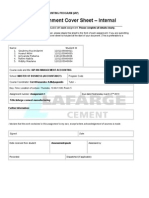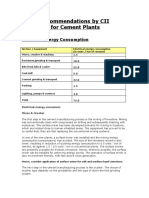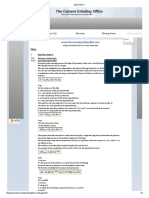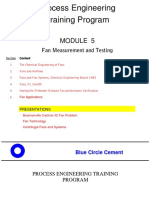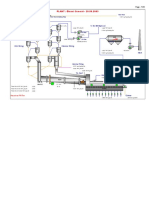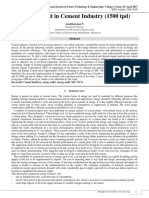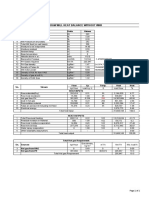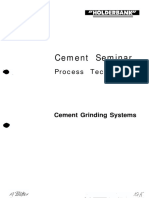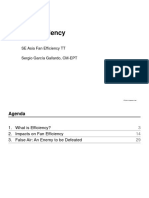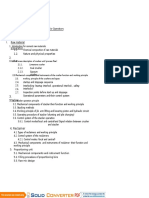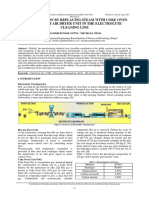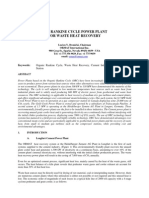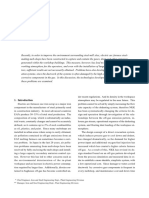Professional Documents
Culture Documents
Gas Flow Optimization For Top Cyclone Preheater Cement Production
Original Title
Copyright
Available Formats
Share this document
Did you find this document useful?
Is this content inappropriate?
Report this DocumentCopyright:
Available Formats
Gas Flow Optimization For Top Cyclone Preheater Cement Production
Copyright:
Available Formats
Volume 6, Issue 9, September – 2021 International Journal of Innovative Science and Research Technology
ISSN No:-2456-2165
Gas flow optimization for Top Cyclone Preheater
Cement Production
Abdul Kayi a*, Isdaryanto a
a
Faculty of engineering, Atma Jaya Catholic University of Indonesia
Abstract:- Application of cyclone technology has been separation and heat utilization is highly dependent on the
implemented in cement production since the cyclone applied. It starts with using the suspension
construction because it is simple, low cost, reliability and preheating method to preheat and partially decompose the
stability both in high pressure environment and high feedstock to reduce the length of the kiln, and at the same
temperature (900 oC). The ideal solution to improve the time, make the raw material, and hot gas flow in the kiln in
burning process is by optimizing the cyclone heat full. The Cyclone Preheater can fully utilize the heat from
exchanger. The aim of this study is to see the effect of the kiln, reduce clinker combustion heat consumption, and
baffle plate for outlet duct to the outlet gas flow reduce combustion equipment floor space [2].
distribution in cyclone preheater CN1–A and CN1–B.
Computational Fluid Dynamics is used for modelling the The advantage of the cyclone preheater is that it has
swirl turbulent flow inside the cyclone. The simulation high productivity where the cyclone preheater adopts the
shows It was found that by adding baffle plate (width multilevel suspension preheating cycle to increase the
between 250–300 mm) able to maximize the gas flow production rate, the low investment cost, due to the
distribution and also improve the heat transfer and reasonable structure of the cyclone preheater, thus reducing
potentially to reduce the loss from heat loss by 0.9–1.3% equipment problems and low investment. Figure 1,
(equivalent 588 – 722 billion Rupiah/year). Baffle plate illustrates the principle of operation of the cyclone
also caused pressure drop in multicyclone system) suspension preheater.
Keywords:- Computational Fluid Dynamics, Efficiency,
Cyclone Geometry, Pressure Drop, Dust Loss, Thermal
Loss.
I. INTRODUCTION
The modern clinker production system consists of a
rotary kiln, a cyclone preheater (suspension preheater), and
a calciner. Cyclone Preheater is the core equipment for
cement production using kiln dry process technology. In this
process, a raw mix with low water content (e.g., 0.5%) is
used, to reduce the need for evaporation and reduce the
length of the kiln. The raw mix is fed into the combined
preheater and pre–calciner equipment, which heats and
partially (almost completely) calcines the raw mix before
reaching the rotary kiln. The calcination process involves
the thermal decomposition of calcite and other carbonate
materials to form metal oxides (mainly CaO) and carbon
dioxide gas. Pre–calciner reduces fuel consumption in the Figure 1. Operation principle of a cyclone Suspension
kiln because the kiln no longer has to perform a calcination Preheater [2]
function. The use of the suspension preheater, which
consists of a series of cyclone stages, also improves energy A cyclone is a static device that applies centrifugal
efficiency. The Cyclone Preheater regulates the raw mix force to a mixture of gas and particles, to promote separation
temperature using the heat generated by the combustion of of the particles from the gas stream. A cyclone has been
fuel or from hot gas fed from the kiln. This preheating widely applied in various industries because of its main
removes carbon dioxide (up to 90%) and water in the raw advantages of simple structure, low cost, and good
mix before entering the kiln. Most suspension preheaters are adaptability to high pressure and high-temperature
equipped with four cyclones [1]. conditions, especially above 900ºC, which hardly includes
the application of other separation technologies [3]–[5].
One of the solutions to increase the thermal efficiency
of the combustion process is by optimizing the cyclone heat
exchanger (suspension preheater). The efficiency of dust
IJISRT21SEP476 www.ijisrt.com 704
Volume 6, Issue 9, September – 2021 International Journal of Innovative Science and Research Technology
ISSN No:-2456-2165
The most important parameters that aim to assess the The main objective of this study is to determine the
performance of the cyclone separator are the pressure drop effect of modification by adding baffle plates to the outlet
and the efficiency of particle collection [6]. The overall duct cyclone preheater as a design optimization step to
collection efficiency is defined as the ratio of the mass of improve gas flow distribution at the outlet ducts coming out
solids collected by the cyclone in time intervals to the mass of the CN1-A and CN1-B cyclones using CFD simulation.
flow rate of incoming solids. The pressure drop is given by So that the balance of gas distribution is expected to reduce
the difference between the static pressure in the cyclone heat loss.
inlet and the gas out [7]–[9]. The investigation is focused on the twin cyclone model
for the 1st stage of the cyclone which operates in a cement
The case study at PT. XYZ shows that the material factory in Indonesia [10]. Figures 2 and 3are cyclone
distribution is not balanced between CN1-A and CN1-B preheaters with modern design features that have several
cyclones so that it has an impact on high thermal loss and advantages including:
dust loss. This also causes the work efficiency of one of the 1) Minimal power requirements due to the high heat
cyclones to decrease because it has to accept a larger dust recovery rate and low-pressure drop;
load. Table 1 below shows the baseline mass flow 2) High efficiency - low heat consumption due to high
distribution values for cyclones CN1-A and CN1-B. cyclone collection rate and uniform meal distribution
over the gas duct cross-section;
Table 1. Mass flow distribution and design vs actual 3) High validity and reliable design.
temperature
However, this model in its application has a different
Mass Flow % Temperature ºC outlet duct length from the two cyclones to the downcomer
Operational CN1- CN1- CN-A CN-B duct as shown in Figure 1, causing an unbalanced
A, B, (short (long distribution of gas outlets.
short long Diff ) ) Diff downcomer
Design 50 50 0 370 370 0 370
Actual 60 40 20 426 366 60 397
Table 1 shows that the mass flow distribution and
temperature are not balanced between CN1-A and CN1-B,
where the initial design values for CN1-A and CN1-B
should be balanced. However actual current operating data
for CN1-A and CN1-B are 60% and 40%. Meanwhile, the
downcomer temperature according to the design is 370ºC,
while the actual temperature is 397ºC. Table 2 shows the
data on efficiency, dust loss, downcomer temperature, and
heat loss.
Table 2. Efficiency, dust loss, downcomer temperature and Figure 2. Top cyclone preheater and outlet duct design
heat loss drawing [11]
Efficiency Temperature Heat Loss,
Operational Cyclone Dust loss Downcomer (MJ/tclinker)
(%) (tpd) (oC)
Design 95.0 200 370 1,185.10
Actual 93.6 256 397 1,271.59
In table 2, the thermal loss value according to the
design can be obtained by calculating the heat carried by air
out of the preheater system. From the calculation results, the
thermal loss value according to the design is 1185.10 MJ / t-
clinker while in actual conditions it is 1271.59 MJ / t-
clinker, there is an increase in heat loss of 86.49 MJ / t-
clinker. The cyclone efficiency value is also directly
proportional to the amount of dust loss in the preheater
system. For a relatively new cyclone system, the efficiency
is in the range of 95% so that the amount of dust loss has a
value of 200 tpd. Meanwhile, in actual conditions, the Figure 3. Outlet duct from top cyclone preheater design
efficiency of the cyclone was 93.6% and the dust loss value drawing different length [11]
was 256 tpd.
IJISRT21SEP476 www.ijisrt.com 705
Volume 6, Issue 9, September – 2021 International Journal of Innovative Science and Research Technology
ISSN No:-2456-2165
This cyclone design has a difference on the top roof
compared to the cyclone design in general, where the
cyclone roof is sloping. The advantage of this cyclone
model is that it has a lower pressure drop compared to the
cyclone design with a flat top roof [12].
II. METHODS
In previous research conducted by Feri, et al [2], CFD
analysis was carried out on a single cyclone, but in this case,
CFD analysis was carried out on a twin cyclone, to find out
how much influence the imbalance of gas outlet distribution Figure 5. Meshing Baseline on Multicyclone Preheater
due to the lengths of the two different duct outlets on
temperature, against thermal loss and mass flow. Then, 2.3 Solution stage (Solver Execution)
determine the corrective steps that need to be taken to At this stage, the equations used in the CFD simulation
optimize the cyclone design so that thermal loss can be will be solved iteratively until they reach a convergent
reduced. condition. The level of accuracy of this solver execution is
influenced by: the level of accuracy of the limitations or
The methodology in this study is an analysis of the gas assumptions used, meshing, and numerical errors (either due
flow conditions in the cyclone preheater with the CFD to software limitations or due to errors in software users).
(Computational Fluid Dynamics) simulation method to
determine the effect of modification with the addition of 2.4. Post Processing Stage
baffle plates and steps to improve it. There are 4 (four) steps At this stage, the results of the CFD simulation that
in conducting a CFD simulation, namely: has been performed will be obtained. The results of this
2.1 Identification of the Problem CFD simulation can be in the form of velocity vector plots,
a. This process is the first step to determine the cause of the pressure distribution contours, the magnitude of
imbalance in the efficiency of the two top cyclone aerodynamic forces, etc. The results we get at this post-
preheaters; processing stage need to be tested again to get more accurate
b. This research was conducted through the process of results.
collecting operational data and clinker production
reports; III. RESULT AND DISCUSSION
c. The fluid domain is the raw mix dust that goes through
the calcination process. The design optimization carried out in this study is by
adding a baffle plate to the outlet duct to balance the gas
2.2 Pre-Processing Stage flow from the top cyclone preheater. To make this research-
a. Creating geometry with geometry build facilities using focused, it is necessary to limit the problems including:
SolidWorks software 1. The simulation is carried out from before the gas is split
from CN2 to CN1-A and CN1-B until the meeting of the
two exhaust gases from CN1-A and CN1-B
2. Operating conditions are taken at a steady-state kiln with
an average production rate of 95%
3. Modifications are made by adding a baffle plate at one of
the duct outlets with a variable baffle plate width of 210
mm, 250 mm and 300 mm.
The first step in the simulation is to determine the
parameters that will serve as the baseline. In table 1, several
parameters that can be used to determine this simulation
Figure 4. 3D Modeling on Multicyclone Preheater with according to actual conditions are the gas mass flow at the
Solidworks output of each cyclone and the gas temperature in the
downcomer. These two parameters were chosen because the
b. Meshing. Determine the type of mesh that will be used. actual data could be taken and also had a big effect on
In this simulation, tetrahedron type meshing is used. unbalancing conditions in the multi-cyclone system.
Figure 5 shows the meshing used in this simulation
IJISRT21SEP476 www.ijisrt.com 706
Volume 6, Issue 9, September – 2021 International Journal of Innovative Science and Research Technology
ISSN No:-2456-2165
Table 3. Mass flow distribution and actual & baseline temperature
Mass Flow % Temperature ºC
Operational
CN1-A, short CN1-B, long Diff CN-A (short) CN-B (long) Diff downcomer
Actual 60 40 20 426 366 60 397
Baseline (simulation) 62.45 37.55 24.9 452.1 406.9 45.2 400.5
In table 3, quantitatively CN1-A has a mass flow of 21.18°C and mass flow distribution is still large CN1-A than
62.45% and CN1-B of 37.55% from the inlet. This value is CN1-B is 15.66%.
comparable to the actual conditions where CN1-A has a
mass flow of 60% and CN1-B has a mass flow of 40%.
From these results, it can be concluded that this baseline can
represent the actual conditions. Furthermore, the data used
to run this baseline simulation will be used to simulate CFD
Cyclone with the condition of the outlet ducts installed with
baffle plates of different sizes.
Figure 8. Temperature profile with the addition of 210 mm
baffle plate
3.2 Modification with 250 mm Baffle Plates
Figure 9 shows the temperature conditions of the
simulation results after adding a baffle plate with a width of
250 mm on the short duct side of CN1-A. The temperature
Figure 6. Temperature profile at baseline conditions difference was around 16.94°C and the mass
From Figure 6, it can be seen that the gas temperature
in the cyclone with a shorter outlet duct (right side) is
brighter, which qualitatively indicates that the cyclone
temperature is hotter. Quantitatively, it is found that the
temperature of the CN1-A cyclone for the short outlet duct
is 452.1 °C, while the temperature in the CN1-B cyclone for
the long outlet duct is 406.9°C.
The modification made to balance the gas flow in this
CFD simulation is to install the baffle plate on the shorter
duct outlet. Position the baffle plates in an easily accessible Figure 9. Temperature profile by adding 250 mm baffle
area for installation and maintenance considerations. Figure plate
7 shows the position of the baffle plate in the simulation.
3.3 Modification with 250 mm Baffle Plates
In a simulation with a baffle plate size of 300 mm, the
temperature difference is the same as the baffle condition of
250 mm, but the mass flow balance has shifted from CN-A
to CN-B by 5.39%.
Figure 7. Position of baffle plate on the shorter outlet duct
3.1 Modification with 210 mm Baffle Plates
Figure 8 shows the temperature conditions of the Figure 10. Temperature profile by adding 300 mm baffle
simulation results after adding a 210 mm wide baffle plate plate
to the short duct of CN1-A. From the simulation data, it is
found that CN1-A temperature is still higher than CN-B at
IJISRT21SEP476 www.ijisrt.com 707
Volume 6, Issue 9, September – 2021 International Journal of Innovative Science and Research Technology
ISSN No:-2456-2165
Table 4. Mass flow distribution and temperature before and 0.59 MJ / s or 1.13% of the baseline and a potential
after simulation savings of 722 million rupiahs per year.
Mass Flow % Temperature c. The addition of a 250 mm baffle plate to the CN1-A duct
CN- outlet has a positive effect on temperature and mass
Operati CN- B Press flow. Where the cyclone CN1-B temperature was
onal CN1- CN1- A (lo ure 16.38°C higher, but CN1-B mass flow was 5.39%
A, sh B, lo (sho ng Dif downco mbar higher. Judging from the heat loss value, there is a
ort ng Diff rt) ) f mer decrease of 0.48 MJ / s or 0.92% and a potential savings
of 584 million rupiahs per year.
Baselin 37.5
From the three tests, the gas flow balance position is
e 62.5% % 25% 452 407 45 400.5 0
achieved when the baffle plate is installed with a width of
Add Baffle Plate between 250 - 300 mm inside the duct outlet of CN1-A.
210 57.83 42.17 15.6 434. 413. 21.
mm % % 6% 2 1 18 398.1 0.99 According to the simulation results in table 4, with the
250 51.88 48.12 3.77 429. 412. 16. addition of baffle plates, the mass flow experienced a
mm % % % 5 6 94 396.3 1.40 significant improvement from 25% to 3.77% and the
- difference in temperature difference decreased from 45°C to
300 47.30 52.70 5.39 415. 431. 16. 16°C. The downcomer temperature has also decreased by
mm % % % 1 5 38 397.1 2.02 approximately 2-4°C, which indicates that the more
balanced flow in the two multi cyclones can increase heat
Based on the simulation results in table 4°, heat loss transfer.
can be calculated using the equation in point 2.2.1 and
converted into rupiah according to the specific thermal cost A decrease in downcomer temperature will also have a
for the use of existing coal. Assuming the material heat positive effect on ID Fan and maintenance. However, the
capacity value (Cp) is considered constant, the production addition of baffle plates also had a negative impact, namely
rate is 95% of the design capacity, the operating time is 310 an increase in pressure drop in the multi-cyclone system by
days in 1 year, then the heat loss value and potential savings 1.40 - 2.02 mbar. This increase in pressure drop needs to be
per year can be seen in table 5. compensated by the ID fan, which in turn will increase the
load on the ID fan and increase the power consumption of
Table 5. Heat loss simulation results and potential savings the ID fan (in good accordance with [13]). Further research
is still needed to be able to analyze the effects of this
He problem.
Baffle at
Temp. Heat Heat Potential
Plate Lo IV. CONCLUSION
downco Improvem Improvemen saving,
Widt ss,
mer, oC ent, MJ/s t, % IDR/year
h M The simulation process uses CFD for twin cyclones
J/s with different outlet duct lengths between CN1-A and CN1-
Base 52. 0 B. From the simulation can be concluded that the gas flow
0
line 400.5 88 0 balance is achieved when the baffle plates are installed with
210 52. 412,430,38 a width between 250 - 300 mm, and causing difference in
0.64
mm 398.1 54 0.34 1.10 mass flow and temperature, Mass flow has decreasing
250 52. 721,753,16 significantly from 25% to the range of 3.77%, as well as the
1.13 temperature has decreasing from the previous 45°C to 16°C.
mm 396.3 29 0.59 6.93
300 52. 584,276,37 Judging from the value of heat loss, the potential savings
0.92 that can be obtained range from 0.9 - 1.3% or equivalent to
mm 397.1 40 0.48 3.23
584 - 722 million rupiah per year. However, this simulation
Based on the three tests carried out on the twin result will certainly provide its own challenges for the next
cyclone, the following CFD simulation results are obtained: researchers, to find out the effect of unbalance gas flow on
a. The addition of a 210 mm baffle plate to the CN1-A duct cyclone efficiency and the effect of increasing pressure drop
outlet did not have a significant effect on temperature and steps to anticipate it.
and mass flow. Where the cyclone CN1-A temperature
was 21.18°C higher and the CN1-A velocity was 15.66% REFERENCES
higher. However, from the heat loss, there is a decrease
of 0.33 MJ / s or 0.64% from the baseline, so there is a [1]. N. A. Madlool, “Assessment of waste preheater gas
potential savings of 421 million Rupiah per year. and dust bypass systems: Al-Muthanna cement plant
b. The addition of a 250 mm baffle plate to the CN1-A duct case study,” Case Stud. Therm. Eng., vol. 8, pp. 330–
outlet has a positive effect on temperature and mass 336, 2016.
flow. Where the cyclone CN1-A temperature was [2]. M. Wasilewski and J. Duda, “Application of
16.94°C higher and mass flow was 3.77% higher. computational fluid dynamics to optimization of
Judging from the heat loss value, there is a decrease of cyclone dust separators operated in the cement
industry,” Chemik, vol. 67, no. 10, pp. 985–994, 2013.
IJISRT21SEP476 www.ijisrt.com 708
Volume 6, Issue 9, September – 2021 International Journal of Innovative Science and Research Technology
ISSN No:-2456-2165
[3]. F. Ficici and V. Ari, “Optimization of the preheater
cyclone separators used in the cement industry,” Int. J.
Green Energy, vol. 10, no. 1, pp. 12–27, 2013.
[4]. B. Zhao and Y. Su, “Artificial neural network-based
modeling of pressure drop coefficient for cyclone
separators,” Chem. Eng. Res. Des., vol. 88, no. 5–6,
pp. 606–613, 2010.
[5]. J. Gimbun, T. G. Chuah, A. Fakhru’l-Razi, and T. S.
Y. Choong, “The influence of temperature and inlet
velocity on cyclone pressure drop: A CFD study,”
Chem. Eng. Process. Process Intensif., vol. 44, no. 1,
pp. 7–12, 2005.
[6]. J. Chen and M. Shi, “A universal model to calculate
cyclone pressure drop,” Powder Technol., vol. 171, no.
3, pp. 184–191, 2007.
[7]. M. Hattingh, I. J. Van der Walt, and F. B. Waanders,
“Comparison of cyclone design methods for removal
of fine particles from plasma generated syngas,” World
Acad. Sci. Eng. Technol., vol. 11, no. 1, pp. 19–27,
2017.
[8]. A. F. Savaş and A. Kolip, “Comparative energy and
exergy analyses of a serial and parallel flow four-stage
cyclone pre-calciner cement plant,” Int. J. Exergy, vol.
17, no. 4, pp. 492–512, 2015.
[9]. D. Jerzy, M. Wasilewski, and J. Duda, “Influence
construction of suspension preheater on energy
consumption process during burning in rotary kiln
Heat Transfer and Renewable Sources of Energy 2012
INFLUENCE CONSTRUCTION OF SUSPENSION
PREHEATER ON ENERGY CONSUMPTION
PROCESS DURING BURNING IN RO,” no.
February, 2014.
[10]. Sriyono, “Analisis Dan Pemodelan Cyclone Separator
Sebagai Prefilter Debu Karbon Pada Sistem Pemurnian
Helium Reaktor Rgtt200K,” Pros. Semin. Nas. ke-18
Teknol. dan Keselam. PLTN Serta Fasilitas Nukl., no.
September, pp. 215–226, 2012.
[11]. A. V. L. L. Gmbh, “Experimental Investigations and
cfd Simulations on Particle Depositions in Gas
Cyclone Separators,” 2014.
[12]. C. Maarup, “Gas-Solid Heat Exchanger for Cement
Industry,” 2013.
[13]. J. Cernecky and K. Plandorova, “The effect of the
introduction of an exit tube on the separation
efficiency in a cyclone,” Brazilian J. Chem. Eng., vol.
30, no. 3, pp. 627–641, 2013.
IJISRT21SEP476 www.ijisrt.com 709
You might also like
- Roller Press Classifier Circulation FactorDocument9 pagesRoller Press Classifier Circulation Factorshahid2995100% (1)
- Kiln Heat BalanceDocument17 pagesKiln Heat BalancegvrrNo ratings yet
- Process Costing LafargeDocument23 pagesProcess Costing LafargeGbrnr Ia AndrntNo ratings yet
- Foster Wheeler CFB BoilerDocument9 pagesFoster Wheeler CFB BoilerErl SuperalNo ratings yet
- The Challenge of Managing Tendinopathy in Competing AthletesDocument7 pagesThe Challenge of Managing Tendinopathy in Competing AthletesMichele MarengoNo ratings yet
- TEFL Entrance ExamDocument3 pagesTEFL Entrance ExammerekNo ratings yet
- AC7140 Rev CDocument73 pagesAC7140 Rev CRanga100% (1)
- Design of Cyclone For Cement FactoryDocument5 pagesDesign of Cyclone For Cement FactoryverygoodbrotherNo ratings yet
- Electrical Energy Module Final Draft 20Document161 pagesElectrical Energy Module Final Draft 20Safrin SangiaNo ratings yet
- GGBFS Opeartion ManualDocument41 pagesGGBFS Opeartion ManualPushpendra Kumar KushwahaNo ratings yet
- Cement Plant-Heat Balance PDFDocument14 pagesCement Plant-Heat Balance PDFtsrinivasan5083No ratings yet
- By-Pass Calculation Method - DocbDocument2 pagesBy-Pass Calculation Method - DocbElwathig BakhietNo ratings yet
- Precalciner Systems Cement IndustryDocument22 pagesPrecalciner Systems Cement IndustryfaheemqcNo ratings yet
- Cement Plant - Energy OptimisationDocument12 pagesCement Plant - Energy OptimisationSatya MakhijaNo ratings yet
- Cyclone SeparatorDocument1 pageCyclone SeparatordadNo ratings yet
- Plant Process Audits2 PDFDocument38 pagesPlant Process Audits2 PDFvilas bollabathiniNo ratings yet
- The Cement Grinding Office: Home About Us Services Mining AreaDocument3 pagesThe Cement Grinding Office: Home About Us Services Mining AreaVisnu SankarNo ratings yet
- Mod 5-Fan Measurement and TestingDocument227 pagesMod 5-Fan Measurement and TestinglovjnxNo ratings yet
- Heat & Mass Equation For CementDocument99 pagesHeat & Mass Equation For Cementamit100% (1)
- Energy Saving Cement PlantDocument19 pagesEnergy Saving Cement PlanttankeanleongNo ratings yet
- Cement Energy GuideDocument70 pagesCement Energy GuideAmr A. NaderNo ratings yet
- Technical Specification of VSK PDFDocument28 pagesTechnical Specification of VSK PDFmaran.suguNo ratings yet
- Bag Filters For Cement IndustryDocument9 pagesBag Filters For Cement Industrymahreza189No ratings yet
- ENERGY STAR Guide For The Cement Industry 28-08-2013 FinalDocument141 pagesENERGY STAR Guide For The Cement Industry 28-08-2013 Finalnsprasad88No ratings yet
- WBCSD Co2 Protocol enDocument80 pagesWBCSD Co2 Protocol enjuan domaniczkyNo ratings yet
- Energy Audit in Cement Industry (1500 TPD)Document7 pagesEnergy Audit in Cement Industry (1500 TPD)IJSTENo ratings yet
- Mod 4 - Process Measurement and TestingDocument272 pagesMod 4 - Process Measurement and Testinglovjnx100% (2)
- Kiln Performance & Efficiency Formulas (Updated and Completed) - InFINITY For CEMENT EQUIPMENTDocument3 pagesKiln Performance & Efficiency Formulas (Updated and Completed) - InFINITY For CEMENT EQUIPMENTBùi Hắc HảiNo ratings yet
- False AirDocument665 pagesFalse AirSantanu PachhalNo ratings yet
- Raw Mill Heat Balance Without WHR: Sn. Parameters Units ValuesDocument3 pagesRaw Mill Heat Balance Without WHR: Sn. Parameters Units ValuesRamachandrarao MaddaliNo ratings yet
- Thermos Design of Rotary Kiln For Reduction of Radiantion LossesDocument20 pagesThermos Design of Rotary Kiln For Reduction of Radiantion LossesMadhav Krishna MNo ratings yet
- Modefied Cooler2Document71 pagesModefied Cooler21977jul100% (2)
- FormulaeDocument163 pagesFormulaeilvspeedNo ratings yet
- DTS - Air To Air Heat Exchanger Data SheetxlsDocument1 pageDTS - Air To Air Heat Exchanger Data SheetxlspawanroyalNo ratings yet
- Raw Mill-Ball Mill Heat BalanceDocument16 pagesRaw Mill-Ball Mill Heat BalanceAbhishekNo ratings yet
- R A R F U: % Passing Size, M Feed Coarse FinesDocument3 pagesR A R F U: % Passing Size, M Feed Coarse FinesAli HüthütNo ratings yet
- Benchmarks IndiaDocument78 pagesBenchmarks IndialafecapoNo ratings yet
- Process Design NotesDocument12 pagesProcess Design NotesAli HüthütNo ratings yet
- Comminution 2Document159 pagesComminution 2Kumar RajeshNo ratings yet
- How To Check Variability of Mass Flow in A Pneumatic Conveying System PDFDocument4 pagesHow To Check Variability of Mass Flow in A Pneumatic Conveying System PDFnazmul hasanNo ratings yet
- SLC-D Cyclone PreheaterDocument55 pagesSLC-D Cyclone PreheaterAdnan Nawaz100% (2)
- MHR21924 CMC Chapter CCDocument48 pagesMHR21924 CMC Chapter CCDede KaladriNo ratings yet
- High-Efficiency Cyclone: Machine Manual En-22330.003-BDocument31 pagesHigh-Efficiency Cyclone: Machine Manual En-22330.003-BRahmat YusufNo ratings yet
- Energy Auditing and Recovery For Dry Type Cement Rotary Kiln Systems A Case StudyDocument12 pagesEnergy Auditing and Recovery For Dry Type Cement Rotary Kiln Systems A Case Study1977julNo ratings yet
- Clinker Vs Kiln Feed FactorDocument3 pagesClinker Vs Kiln Feed FactorSSAC PVT.LTD.100% (1)
- Cement Grinding SystemsDocument33 pagesCement Grinding Systemskamal yashwanth gNo ratings yet
- Mod 8-Application of Heat and Mass BalancesDocument218 pagesMod 8-Application of Heat and Mass BalanceslovjnxNo ratings yet
- Fan EfficiencyDocument36 pagesFan EfficiencyGaluh Almas100% (1)
- Cement Grinding Unit - QuestionnaireDocument6 pagesCement Grinding Unit - QuestionnaireVaibhav KhodakeNo ratings yet
- Coal Mills PDFDocument16 pagesCoal Mills PDFvtbkNo ratings yet
- Training Contents For OperatorsDocument7 pagesTraining Contents For OperatorsmkpqNo ratings yet
- Line I Heat BalanceDocument60 pagesLine I Heat Balancehmaza shakeelNo ratings yet
- Energies: CFD Analysis of Regenerative Chambers For Energy Efficiency Improvement in Glass Production PlantsDocument17 pagesEnergies: CFD Analysis of Regenerative Chambers For Energy Efficiency Improvement in Glass Production Plantspuyang48No ratings yet
- Mathematical Modelling of The Cement Clinker Burning ProcessDocument5 pagesMathematical Modelling of The Cement Clinker Burning ProcessTahseen AlHattabNo ratings yet
- DryerDocument4 pagesDryerJAGDISHNo ratings yet
- Organic Rankine Cycle Power PlantDocument6 pagesOrganic Rankine Cycle Power PlantPower PowerNo ratings yet
- ASME90 GT 335 BollandDocument9 pagesASME90 GT 335 Bollandank_mehraNo ratings yet
- Section 9 Electricity GenerationDocument23 pagesSection 9 Electricity GenerationhaqjmiNo ratings yet
- Truyền Nhiệt Trong Lò NungDocument8 pagesTruyền Nhiệt Trong Lò Nungmap vitcoNo ratings yet
- Modelling of Flexible Boiler Operation in Coal FirDocument8 pagesModelling of Flexible Boiler Operation in Coal FirAl Qohyum FernandoNo ratings yet
- Ormat Technologies Inc. - Organic Rankine Cycle Power Plant For Waste Heat Recovery - 2013-05-09Document5 pagesOrmat Technologies Inc. - Organic Rankine Cycle Power Plant For Waste Heat Recovery - 2013-05-09Anonymous Cxriyx9HIX100% (1)
- International Journal of Heat and Mass Transfer: Miguel Chávez-Modena, Leo Miguel González, Eusebio ValeroDocument15 pagesInternational Journal of Heat and Mass Transfer: Miguel Chávez-Modena, Leo Miguel González, Eusebio ValeroGuilherme RighetoNo ratings yet
- Progress of Emission Control System in EAF ShopsDocument8 pagesProgress of Emission Control System in EAF ShopsJoão CoelhoNo ratings yet
- Factors Influencing The Use of Improved Maize Seed and Participation in The Seed Demonstration Program by Smallholder Farmers in Kwali Area Council Abuja, NigeriaDocument6 pagesFactors Influencing The Use of Improved Maize Seed and Participation in The Seed Demonstration Program by Smallholder Farmers in Kwali Area Council Abuja, NigeriaInternational Journal of Innovative Science and Research TechnologyNo ratings yet
- Study Assessing Viability of Installing 20kw Solar Power For The Electrical & Electronic Engineering Department Rufus Giwa Polytechnic OwoDocument6 pagesStudy Assessing Viability of Installing 20kw Solar Power For The Electrical & Electronic Engineering Department Rufus Giwa Polytechnic OwoInternational Journal of Innovative Science and Research TechnologyNo ratings yet
- Unmasking Phishing Threats Through Cutting-Edge Machine LearningDocument8 pagesUnmasking Phishing Threats Through Cutting-Edge Machine LearningInternational Journal of Innovative Science and Research TechnologyNo ratings yet
- An Industry That Capitalizes Off of Women's Insecurities?Document8 pagesAn Industry That Capitalizes Off of Women's Insecurities?International Journal of Innovative Science and Research TechnologyNo ratings yet
- Blockchain Based Decentralized ApplicationDocument7 pagesBlockchain Based Decentralized ApplicationInternational Journal of Innovative Science and Research TechnologyNo ratings yet
- Cyber Security Awareness and Educational Outcomes of Grade 4 LearnersDocument33 pagesCyber Security Awareness and Educational Outcomes of Grade 4 LearnersInternational Journal of Innovative Science and Research TechnologyNo ratings yet
- Insights Into Nipah Virus: A Review of Epidemiology, Pathogenesis, and Therapeutic AdvancesDocument8 pagesInsights Into Nipah Virus: A Review of Epidemiology, Pathogenesis, and Therapeutic AdvancesInternational Journal of Innovative Science and Research TechnologyNo ratings yet
- Parastomal Hernia: A Case Report, Repaired by Modified Laparascopic Sugarbaker TechniqueDocument2 pagesParastomal Hernia: A Case Report, Repaired by Modified Laparascopic Sugarbaker TechniqueInternational Journal of Innovative Science and Research TechnologyNo ratings yet
- Smart Health Care SystemDocument8 pagesSmart Health Care SystemInternational Journal of Innovative Science and Research TechnologyNo ratings yet
- Smart Cities: Boosting Economic Growth Through Innovation and EfficiencyDocument19 pagesSmart Cities: Boosting Economic Growth Through Innovation and EfficiencyInternational Journal of Innovative Science and Research TechnologyNo ratings yet
- Impact of Silver Nanoparticles Infused in Blood in A Stenosed Artery Under The Effect of Magnetic Field Imp. of Silver Nano. Inf. in Blood in A Sten. Art. Under The Eff. of Mag. FieldDocument6 pagesImpact of Silver Nanoparticles Infused in Blood in A Stenosed Artery Under The Effect of Magnetic Field Imp. of Silver Nano. Inf. in Blood in A Sten. Art. Under The Eff. of Mag. FieldInternational Journal of Innovative Science and Research TechnologyNo ratings yet
- Diabetic Retinopathy Stage Detection Using CNN and Inception V3Document9 pagesDiabetic Retinopathy Stage Detection Using CNN and Inception V3International Journal of Innovative Science and Research TechnologyNo ratings yet
- Visual Water: An Integration of App and Web To Understand Chemical ElementsDocument5 pagesVisual Water: An Integration of App and Web To Understand Chemical ElementsInternational Journal of Innovative Science and Research TechnologyNo ratings yet
- Compact and Wearable Ventilator System For Enhanced Patient CareDocument4 pagesCompact and Wearable Ventilator System For Enhanced Patient CareInternational Journal of Innovative Science and Research TechnologyNo ratings yet
- Harnessing Open Innovation For Translating Global Languages Into Indian LanuagesDocument7 pagesHarnessing Open Innovation For Translating Global Languages Into Indian LanuagesInternational Journal of Innovative Science and Research TechnologyNo ratings yet
- Air Quality Index Prediction Using Bi-LSTMDocument8 pagesAir Quality Index Prediction Using Bi-LSTMInternational Journal of Innovative Science and Research TechnologyNo ratings yet
- Predict The Heart Attack Possibilities Using Machine LearningDocument2 pagesPredict The Heart Attack Possibilities Using Machine LearningInternational Journal of Innovative Science and Research TechnologyNo ratings yet
- Keywords:-Ibadhy Chooranam, Cataract, Kann Kasam,: Siddha Medicine, Kann NoigalDocument7 pagesKeywords:-Ibadhy Chooranam, Cataract, Kann Kasam,: Siddha Medicine, Kann NoigalInternational Journal of Innovative Science and Research TechnologyNo ratings yet
- An Analysis On Mental Health Issues Among IndividualsDocument6 pagesAn Analysis On Mental Health Issues Among IndividualsInternational Journal of Innovative Science and Research TechnologyNo ratings yet
- Parkinson's Detection Using Voice Features and Spiral DrawingsDocument5 pagesParkinson's Detection Using Voice Features and Spiral DrawingsInternational Journal of Innovative Science and Research TechnologyNo ratings yet
- The Relationship Between Teacher Reflective Practice and Students Engagement in The Public Elementary SchoolDocument31 pagesThe Relationship Between Teacher Reflective Practice and Students Engagement in The Public Elementary SchoolInternational Journal of Innovative Science and Research TechnologyNo ratings yet
- The Making of Object Recognition Eyeglasses For The Visually Impaired Using Image AIDocument6 pagesThe Making of Object Recognition Eyeglasses For The Visually Impaired Using Image AIInternational Journal of Innovative Science and Research TechnologyNo ratings yet
- Advancing Healthcare Predictions: Harnessing Machine Learning For Accurate Health Index PrognosisDocument8 pagesAdvancing Healthcare Predictions: Harnessing Machine Learning For Accurate Health Index PrognosisInternational Journal of Innovative Science and Research TechnologyNo ratings yet
- Implications of Adnexal Invasions in Primary Extramammary Paget's Disease: A Systematic ReviewDocument6 pagesImplications of Adnexal Invasions in Primary Extramammary Paget's Disease: A Systematic ReviewInternational Journal of Innovative Science and Research TechnologyNo ratings yet
- Investigating Factors Influencing Employee Absenteeism: A Case Study of Secondary Schools in MuscatDocument16 pagesInvestigating Factors Influencing Employee Absenteeism: A Case Study of Secondary Schools in MuscatInternational Journal of Innovative Science and Research TechnologyNo ratings yet
- Dense Wavelength Division Multiplexing (DWDM) in IT Networks: A Leap Beyond Synchronous Digital Hierarchy (SDH)Document2 pagesDense Wavelength Division Multiplexing (DWDM) in IT Networks: A Leap Beyond Synchronous Digital Hierarchy (SDH)International Journal of Innovative Science and Research TechnologyNo ratings yet
- The Utilization of Date Palm (Phoenix Dactylifera) Leaf Fiber As A Main Component in Making An Improvised Water FilterDocument11 pagesThe Utilization of Date Palm (Phoenix Dactylifera) Leaf Fiber As A Main Component in Making An Improvised Water FilterInternational Journal of Innovative Science and Research TechnologyNo ratings yet
- Formulation and Evaluation of Poly Herbal Body ScrubDocument6 pagesFormulation and Evaluation of Poly Herbal Body ScrubInternational Journal of Innovative Science and Research TechnologyNo ratings yet
- Terracing As An Old-Style Scheme of Soil Water Preservation in Djingliya-Mandara Mountains - CameroonDocument14 pagesTerracing As An Old-Style Scheme of Soil Water Preservation in Djingliya-Mandara Mountains - CameroonInternational Journal of Innovative Science and Research TechnologyNo ratings yet
- The Impact of Digital Marketing Dimensions On Customer SatisfactionDocument6 pagesThe Impact of Digital Marketing Dimensions On Customer SatisfactionInternational Journal of Innovative Science and Research TechnologyNo ratings yet
- PLX Model OfficialDocument105 pagesPLX Model OfficialBảo Ngọc LêNo ratings yet
- SLHT Grade 7 CSS Week 5 Without Answer KeyDocument6 pagesSLHT Grade 7 CSS Week 5 Without Answer KeyprinceyahweNo ratings yet
- Combat Storm - Shipping ContainerDocument6 pagesCombat Storm - Shipping ContainermoiNo ratings yet
- Fbla Scavenger Hunt 1Document3 pagesFbla Scavenger Hunt 1api-472648158No ratings yet
- Autodesk Design Review: About DWF and DWFXDocument7 pagesAutodesk Design Review: About DWF and DWFXNesreNo ratings yet
- Victaulic-FP-FireLock Fire-Pac Series 745 PreactionDocument9 pagesVictaulic-FP-FireLock Fire-Pac Series 745 PreactionTấn ĐạtNo ratings yet
- SOP For Operation & Calibration of PH Meter - QualityGuidancesDocument9 pagesSOP For Operation & Calibration of PH Meter - QualityGuidancesfawaz khalilNo ratings yet
- IPT .Quarter 2 (Grade 7-Mathematics, English &TLE)Document2 pagesIPT .Quarter 2 (Grade 7-Mathematics, English &TLE)ARRIANE JOY TOLEDONo ratings yet
- Imcp - RocketbookDocument11 pagesImcp - Rocketbookapi-690398026No ratings yet
- Biography of Anna HazareDocument4 pagesBiography of Anna HazareGenesis FirstNo ratings yet
- Cyrille MATH INVESTIGATION Part2Document18 pagesCyrille MATH INVESTIGATION Part2Jessie jorgeNo ratings yet
- Intermediate Programming (Java) 1: Course Title: Getting Started With Java LanguageDocument11 pagesIntermediate Programming (Java) 1: Course Title: Getting Started With Java LanguageRickCy Perucho PccbsitNo ratings yet
- A Control Method For Power-Assist Devices Using A BLDC Motor For Manual WheelchairsDocument7 pagesA Control Method For Power-Assist Devices Using A BLDC Motor For Manual WheelchairsAhmed ShoeebNo ratings yet
- Cambridge IGCSE Physics 0625 Complete Notes PDocument5 pagesCambridge IGCSE Physics 0625 Complete Notes PYamikani ManthandoNo ratings yet
- Unit 4 Transistor Frequency ResponseDocument6 pagesUnit 4 Transistor Frequency ResponseShaina MabborangNo ratings yet
- ROXAS FARM SCHOOL Trifold BrochureDocument2 pagesROXAS FARM SCHOOL Trifold BrochureJude IledanNo ratings yet
- NCP81205Document1 pageNCP81205Tom TomNo ratings yet
- Hybrid Neural-Network - Genetic Algorithm Technique For Aircraft Engine Performance Diagnostics Developed and DemonstratedDocument4 pagesHybrid Neural-Network - Genetic Algorithm Technique For Aircraft Engine Performance Diagnostics Developed and Demonstratedmohamad theibechNo ratings yet
- Spike Magazine Cup PackDocument5 pagesSpike Magazine Cup PackBungle MarleyNo ratings yet
- H I Ôn Thi Aptis & Vstep - Tài Liệu - Anna MaiDocument4 pagesH I Ôn Thi Aptis & Vstep - Tài Liệu - Anna Maihanh.mt2022No ratings yet
- Federal Government Employees Housing FoundationDocument2 pagesFederal Government Employees Housing FoundationMuhammad Shakil JanNo ratings yet
- ATA212001Document3 pagesATA212001Tarek DeghedyNo ratings yet
- T10 - PointersDocument3 pagesT10 - PointersGlory of Billy's Empire Jorton KnightNo ratings yet
- Modal Verbs of Ability and PossibilityDocument12 pagesModal Verbs of Ability and PossibilitymslolinrNo ratings yet
- Portfolio Eelco Maan - 06-2017Document25 pagesPortfolio Eelco Maan - 06-2017tungaas20011No ratings yet
- Esp8285 Datasheet enDocument29 pagesEsp8285 Datasheet enJohn GreenNo ratings yet
- Definition Nature and Scope of Urban GeographyDocument4 pagesDefinition Nature and Scope of Urban Geographysamim akhtarNo ratings yet


